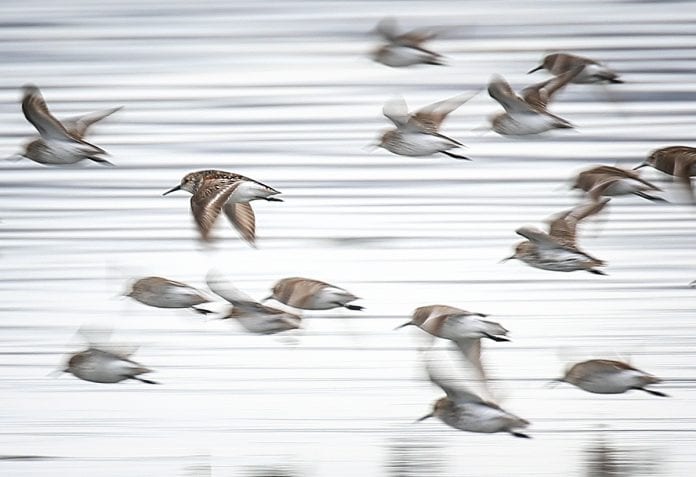
Billions of birds common across the United States and Canada are sounding a new alarm on the impact of human activity on the health of Earth’s environment.
A study published on Thursday, Sept. 19 in the journal Science by Cornell University shows pervasive losses of nearly 3 billion birds across all habitats in North America since 1970, due to human activities. Researchers say it signals that natural systems across the U.S. and Canada are so severely impacted by human activities that they can no longer support the same robust wildlife populations.
“Multiple, independent lines of evidence show a massive reduction in the abundance of birds,” said Ken Rosenberg, lead author of the study and a senior scientist at the Cornell Lab of Ornithology and American Bird Conservancy.
“We expected to see continuing declines of threatened species,” Rosenberg said. “But for the first time, the results also showed pervasive losses among common birds across all habitats, including backyard birds.”
Study results were also reported by EurekAlert, the online science news service of the American Association for the Advancement of Science.
Researchers found that of nearly 3 billion birds lost, 90 percent belong to 10 bird families, including sparrows, warblers, finches and swallows – common, widespread species with influential roles in food webs and ecosystem functioning, from seed dispersal to pest control.
Among the steep declines in bird populations are shorebirds, most of which frequent sensitive coastal habitats, who were already in dangerously low numbers and have lost more than one-third of their population.
Grassland birds have suffered a 53 percent reduction in population, over 700 million of them since 1970, and the volume of spring migration, measured by radar in the night skies, has dropped by 14 percent in the past decade alone.
According to Peter Marra, director of the Georgetown Environment Initiative at Georgetown University, this data is consistent with what scientists are seeing elsewhere with other species showing massive declines, including insects and amphibians.
“It’s imperative to address immediate and ongoing threats, both because the domino effects can lead to the decay of ecosystems that humans depend on for our own health and livelihoods – and because people all over the world cherish birds in their own right. Can you imagine a world without birdsong?” he asked.
The study notes that evidence of the declines emerged from detection of migratory birds in the air from 143 NEXRAD weather radar stations across the continent in a period spanning over a decade, as well as from nearly 50 years of data collected through multiple monitoring efforts on the ground.
Coauthor John Sauer of the US. Geological Survey said the study results also provide insight into actions that can be taken to reverse the declines. The analysis included citizen-science data from the North American Breeding Bird Survey coordinated by the USGS and the Canadian Wildlife Service, the main sources of long-term, large-scale population data for North American birds – the Audubon Christmas Bird Count, and Manomet’s International Shorebird Survey.
While the study did not analyze cause of declines, it noted the steep drop in North American birds parallels losses of birds elsewhere in the world, which suggests multiple interacting causes that reduce breeding success and increase mortality. The largest factor driving these declines is likely widespread loss and degradation of habitat.
Other studies have documented the impact of the pervasive use of pesticides associated with widespread declines in insects, an essential food source for birds. Climate change is expected to compound these challenges by altering habitats and threatening plants birds need to survive. More research is needed to pinpoint primary causes for declines in individual species, researchers said.
Unrelated to this study, federal wildlife officials earlier in September reported the deaths of thousands of seabirds across Western Alaska, from Bristol Bay to the Chukchi Sea, in what has become the fifth straight year of a high number of seabird deaths in areas with warming sea temperatures. The National Park Service is working with the U.S. Fish and Wildlife Service to pinpoint cause of death. Bird carcasses have been sent to the U.S. Geological Survey National Wildlife Health Center for testing. Initial results indicate starvation as the cause of death, but tissue samples will also be analyzed for harmful algal bloom toxins.
Meanwhile there are many ways to help save birds, said Michael Parr, another co-author and president of the American Bird Conservancy, including strengthening the Migratory Bird Treaty Act, banning harmful pesticides and proper funding of bird conservation programs.
The study also documents rebounds as a result of human efforts, including the recovery of waterfowl over the past half century, made possible by conservation investments by hunters and billions of dollars of government funding for wetland protection and restoration. Bald eagles also have made a major comeback since the 1970s, thanks to the banning of the pesticide DDT and endangered species legislation in the U.S. and Canada, the study said.
The study is backed by the American Bird Conservancy, Bird Conservancy of the Rockies, the Cornell Lab of Ornithology, Environment and Climate Change Canada, The Georgetown Environment Initiative and the Smithsonian Migratory Bird Center.





